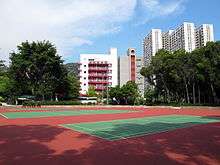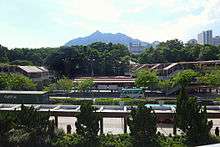Tuen Mun Park
| Tuen Mun Park | |
|---|---|
| 屯門公園 | |
|
Entrance pavilion | |
| Location | Tuen Mun New Town |
| Area | 12.5 hectares |
| Opened |
1985 (Phase I) 1988 (Phase II) 1991 (Phase III) |
| Operated by | Leisure and Cultural Services Department |
| Public transit access |
Town Centre Stop (Light Rail) Tuen Mun Station (West Rail) |




Tuen Mun Park (Chinese: 屯門公園), formerly known as Tuen Mun Town Park, is located in Tuen Mun;[1] it is the largest park in the New Territories, Hong Kong, covering 12.5 hectares (31 acres).[2]
Location
The park is at Tuen Mun Town Centre, with Tuen Mun MTR Station and Light Rail Town Centre Stop being next to it; it is near Tuen Mun Town Plaza, Tuen Mun Public Library and Tuen Mun Town Hall.
History
The park originally fell under the purview of the Regional Council. It won the Hong Kong Institute of Landscape Architects Silver Medal in 1990.[3]
The park has made headlines over controversy surrounding noise generated by musicians in the park. Neighbours of the park long complained of the noise nuisance, while others defended the primarily retired singers who congregated in the park. In 2006, the LCSD proposed to designate special areas in the park for singing and performance with no external amplification allowed, while singing groups complained that singing without amplification was akin to "cooking without salt".[4] Nearby residents groups complained the plan was insufficient, with a Kam Wah Garden resident stating that the performances were a "poison to us all" and lamenting the perpetual need to close all the windows at home.[5] A proposal to build a noise barrier was scrapped after the Architectural Services Department determined that the barrier would increase traffic noise by reflecting it back toward the residential area.[6]
Facilities
The Reptile House
Opened in 1999, the Reptile House is one of the first of its kind in the Leisure and Cultural Services Department. It is situated at the turfed area in the southern part of the park and has a floor area of about 245 square metres. Facilities in the Reptile House include indoor terraria and a courtyard terrarium where various species of reptiles are displayed. At present, there are 20 species in 43 live exhibits displayed in the House. Besides, graphic display of relevant information and 7 reptile models are also provided. With its annual patronage of 400,000 including 75,000 group visitors, the Reptile House is becoming one of the major vantage points in the park.
Species include: Bearded Dragon, Cuban Anole, Boa Constrictor, Veiled Chameleon, Western Painted Turtle, Tokay Geoko, Leopard Gecko, Star Tortoise, Spurred Tortoise, Iguana, Thai Water Dragon, Ball Python, Blue-tongued Skink, Spectacled Caiman.[7]
Other features
- Amphitheatre
- Artificial lake
- Badminton/volleyball courts
- Canteen
- Children's playground
- Model boat pool
- Roller skating rink
- Water cascade
References
- ↑ Koon Kwai Wong; Xiaojiang Yu (2009). Recreation conflict perceptions of urban park visitors: a case study of Tuen Mun Park, Hong Kong, China. Hong Kong Baptist University. pp. 1–29. ISBN 978-962-8804-82-5.
- ↑ Howlett, Bob (1996). Hong Kong 1996 : a review of 1995 and a pictorial review of the past fifty years. Hong Kong: Government Information Services. p. 365. ISBN 978-962-02-0220-9.
- ↑ Bakar, Jamil Abu (2002). A design guide of public parks in Malaysia. Universiti Teknologi Malaysia. p. 27. ISBN 978-983-52-0274-2.
- ↑ Kwong, Robin (25 February 2006). "Government to give noisy park quiet entertainers". South China Morning Post.
- ↑ Lam, Agnes (6 March 2006). "Plan for music zones in park fails to soothe residents' nerves". South China Morning Post.
- ↑ Lam, Agnes (16 August 2006). "Barrier plan to cut noise from park singers is scrapped". South China Morning Post.
- ↑ The Reptile House
External links
| Wikimedia Commons has media related to Tuen Mun Park. |
Coordinates: 22°23′32″N 113°58′25″E / 22.39209°N 113.97372°E
